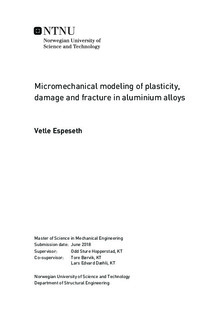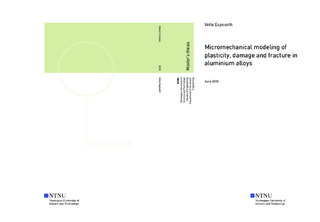| dc.contributor.advisor | Hopperstad, Odd Sture | |
| dc.contributor.advisor | Børvik, Tore | |
| dc.contributor.advisor | Dæhli, Lars Edvard | |
| dc.contributor.author | Espeseth, Vetle | |
| dc.date.accessioned | 2019-09-11T08:35:14Z | |
| dc.date.created | 2018-06-11 | |
| dc.date.issued | 2018 | |
| dc.identifier | ntnudaim:18844 | |
| dc.identifier.uri | http://hdl.handle.net/11250/2614927 | |
| dc.description.abstract | A microstructure-based modeling framework for ductile damage and failure has been examined and validated with experiments for an AlMgSi aluminium alloy. A limited number of material tests has been used to calibrate a porous plasticity model and different fracture models.
The nucleation, growth, and coalescence of voids characterize the mechanisms of ductile damage and fracture. Simulations on an initially voided 3D micromechanical unit cell have been conducted to assess the growth phase and onset of coalescence. The ductility of the unit cell was found to decrease with increasing stress triaxiality. Furthermore, the stress-strain response of the unit cell was used to optimize the Gurson-Tvergaard model. In general, the softening predicted by this calibrated model was found to be too modest compared to experimental data. An examination on coalescence was also performed to assess the critical porosity level.
Strain localization analyses have been conducted to evaluate when the strain localizes into a narrow band, which is a frequent precursor to failure. An imperfection band approach has been used, where the band material was modeled by applying the Gurson-Tvergaard model optimized from both unit cells and experiments. Inadequate predictions of the global failure strain were obtained from the model calibrated from unit cells. The localization analysis was also utilized to calibrate the material parameters of the band material using the failure strain from a single smooth axisymmetric tensile specimen. This approach was found to give satisfactory results.
Numerical analyses of a pre-damaged plate subjected to a blast load were conducted to examine how the different calibrated failure criteria perform in a large-scale problem. Considerable differences were found between the different criteria. The calibration approach of using a smooth specimen test with the localization analysis provided the most convincing results. It is suggested that a purely microstructure-based modeling framework is ambitious. | en |
| dc.language | eng | |
| dc.publisher | NTNU | |
| dc.subject | Produktutvikling og produksjon, Industriell mekanikk | en |
| dc.title | Micromechanical modeling of plasticity, damage and fracture in aluminium alloys | en |
| dc.type | Master thesis | en |
| dc.source.pagenumber | 201 | |
| dc.contributor.department | Norges teknisk-naturvitenskapelige universitet, Fakultet for ingeniørvitenskap,Institutt for konstruksjonsteknikk | nb_NO |
| dc.date.embargoenddate | 2021-06-11 | |

